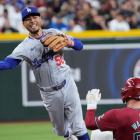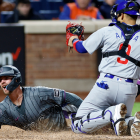On Tuesday, Major League Baseball delivered its salary reduction proposal to the MLB Players Association. It was not the rumored 50-50 revenue split plan. Instead, MLB proposed a sliding scale in which the highest-paid players receive a larger pay cut than players making the league minimum. The MLBPA reportedly called the plan "disappointing."
"We made a proposal to the union that is completely consistent with the economic realities facing our sport. We look forward to a responsive proposal from the MLBPA," an MLB spokesman said.
Tuesday's proposal includes several tiers along the sliding scale. As ESPN's Jeff Passan notes, the game's highest paid players are being asked to surrender much more than half their pay this season, while players at the bottom of the salary scale will be made close to whole under Tuesday's proposal. Reminder: MLB and the MLBPA agreed to prorated salaries in March.
Potential salary cuts in MLB plan, sources tell @JesseRogersESPN and me:
— Jeff Passan (@JeffPassan) May 26, 2020
Full-year Proposal
$563.5K $262K
$1M $434K
$2M $736K
$5M $1.64M
$10M $2.95M
$15M $4.05M
$20M $5.15M
$25M $6.05M
$30M $6.95M
$35M $7.84M
The New York Yankees have baseball's highest full season payroll this year at $260 million and they have players at nearly every stop along the sliding scale. Let's use the proposed 82-game season and four Yankees to show how the sliding scale salary reductions would work for everyone from a pitcher with a record-breaking contract to someone making close to the league minimum:
| Full season salary | 82-game prorated salary | Sliding scale salary | Total pay reduction | |
|---|---|---|---|---|
$36 million | $18.22 million | $8.06 million | 77.6% | |
$10 million | $5.06 million | $2.95 million | 70.5% | |
$5 million | $2.53 million | $1.64 million | 67.2% | |
$579,200 | $294,175 | $269,300 | 53.5% |
There was more than $4.25 billion in player salaries on the books this season prior to the shutdown. The 82-game season knocks that down to a bit more than $2 billion. The sliding scale plan reduces that even further to $1.5 billion or so.
MLB's proposal could put the game's highest-paid players at odds with the lowest-paid players and that is in no way an accident. Beyond the 2020 season, the current collective bargaining agreement expires next December, and creating a fracture within the union works to the owners' advantage long-term. It also increases the likelihood of a work stoppage.
"They've just taken the biggest problem in the union, the pay class divide, and flipped it on its head," one player told SNY's Andy Martino. "And now they'll watch as the union tears itself apart as the highest paid fight back on this while the lowest paid say 'whoa whoa whoa, we like this!' The union will try to convince those young, naive players that it's in their interest to stand together, but it isn't."
MLB's proposal was almost certainly dead on arrival. The MLBPA won't allow the game's biggest stars to accept such massive pay cuts. That is not a precedent the union wants to set, especially after already agreeing to prorated salaries. More than anything, the proposal is designed to make the players look greedy, nevermind that the owners are asking them to offset their losses.
The March agreement calls for MLB and the MLBPA to "discuss in good faith the economic feasibility of playing games in the absence of spectators," which only allows for further salary negotiations. It does not require an agreement. If the MLBPA doesn't play along, MLB could cancel the season, and they're setting the union up to take the blame if that happens.
The bet here is the season will not be canceled because some revenue is better than no revenue, even with the players making their full prorated salaries. Also, with tens of millions losing their jobs across the country, MLB canceling a season over money would do incalculable damage to the sport. It would make the 1994-95 work stoppage look like child's play.
As a baseball fan, it's easy to be discouraged by Tuesday's proposal because it makes baseball seem so far away. And, truth be told, this is maybe the most important week of labor talks since 1995. At the same time, MLB and the MLBPA were never going to agree on the initial proposal. What happens next is far more important than what happened Tuesday.






















